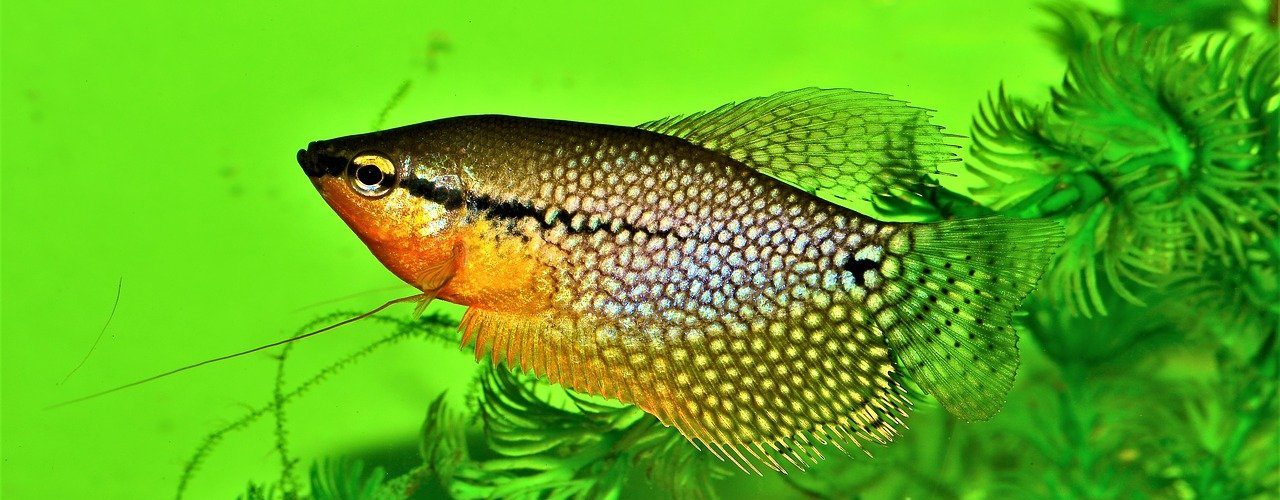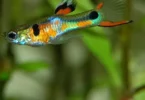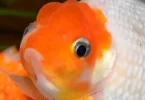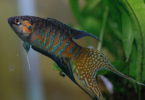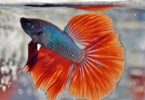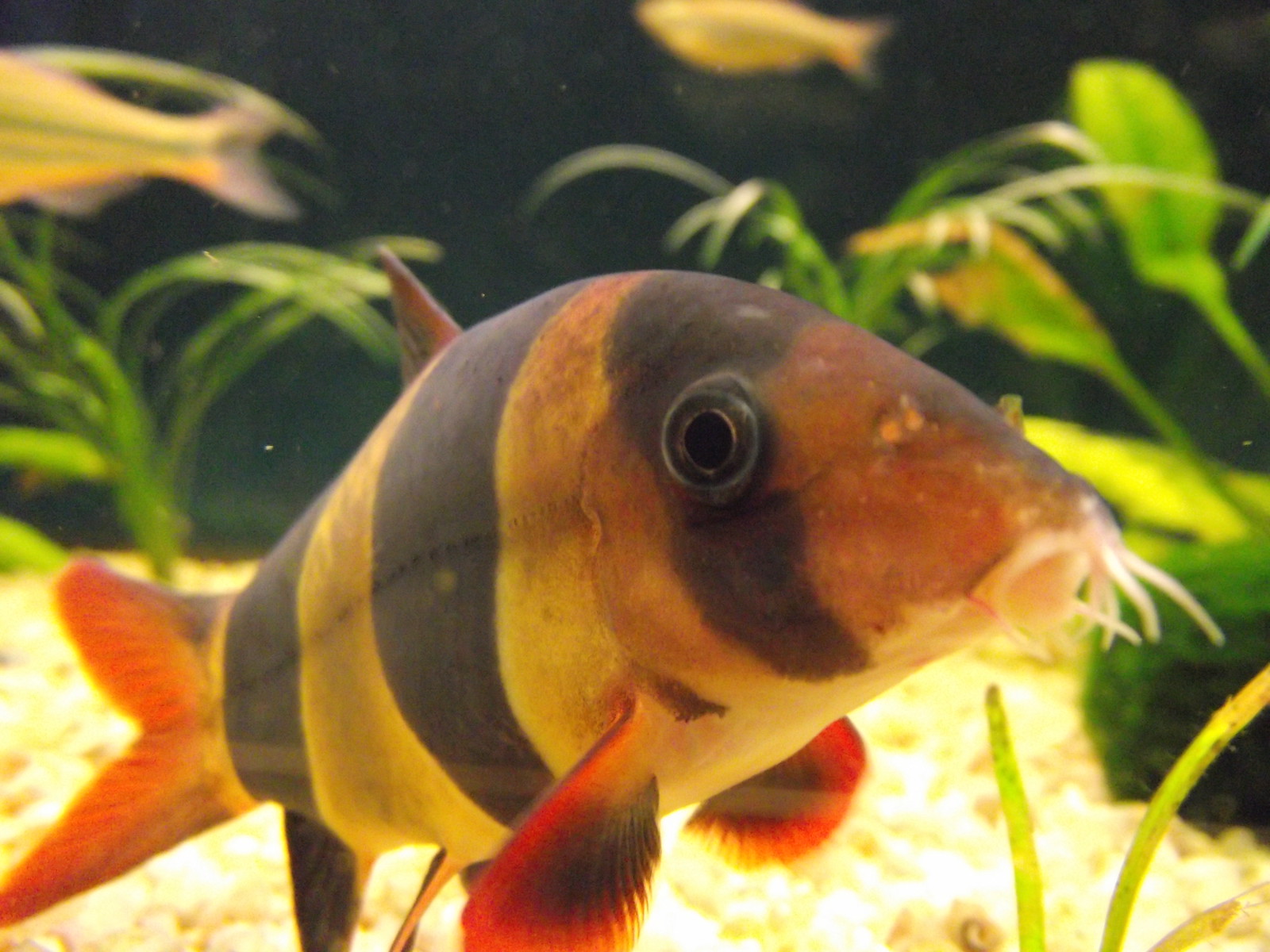Last Updated on February 10, 2023 by Matt
BACKGROUND INFORMATION AND OVERVIEW
The scientific name for the Pearl Gourami is Trichogaster Leeri. They are freshwater fish from a family known as the Osphronemidae, which in turn is one of four families forming a larger grouping of fish known as Anabantids. The anabantids form a large group of fish that can be found in Asia and Africa in tropical waters.
| Pearl Gourami | Description |
|---|---|
| Origin: | Native to Borneo, Malaysia and Sumatra |
| Average Size: | 3 inches |
| Habitat: | Lowland swamps |
| Behavior: | Peaceful |
| Species: | Belontiidae |
| Diet: | Omnivore |
| Water Conditions: | 75-86° F, KH 5-18, pH 6.5-8.0 |
| Color: | Pearl White and Gold |
In the wild, the Pearl Gourami fish are themselves native to Asia and SouthEast Asia, including Pakistan, India, Indonesia, Thailand and Malaysia and also Borneo and Sumatra. In fact, the name Gourami comes from the Indonesian language.
Their natural habitat is the shallow tropical waters; they prefer the lowland swamps in close proximity to the sea, which offer the acidic waters that Pearl Gouramis favour.
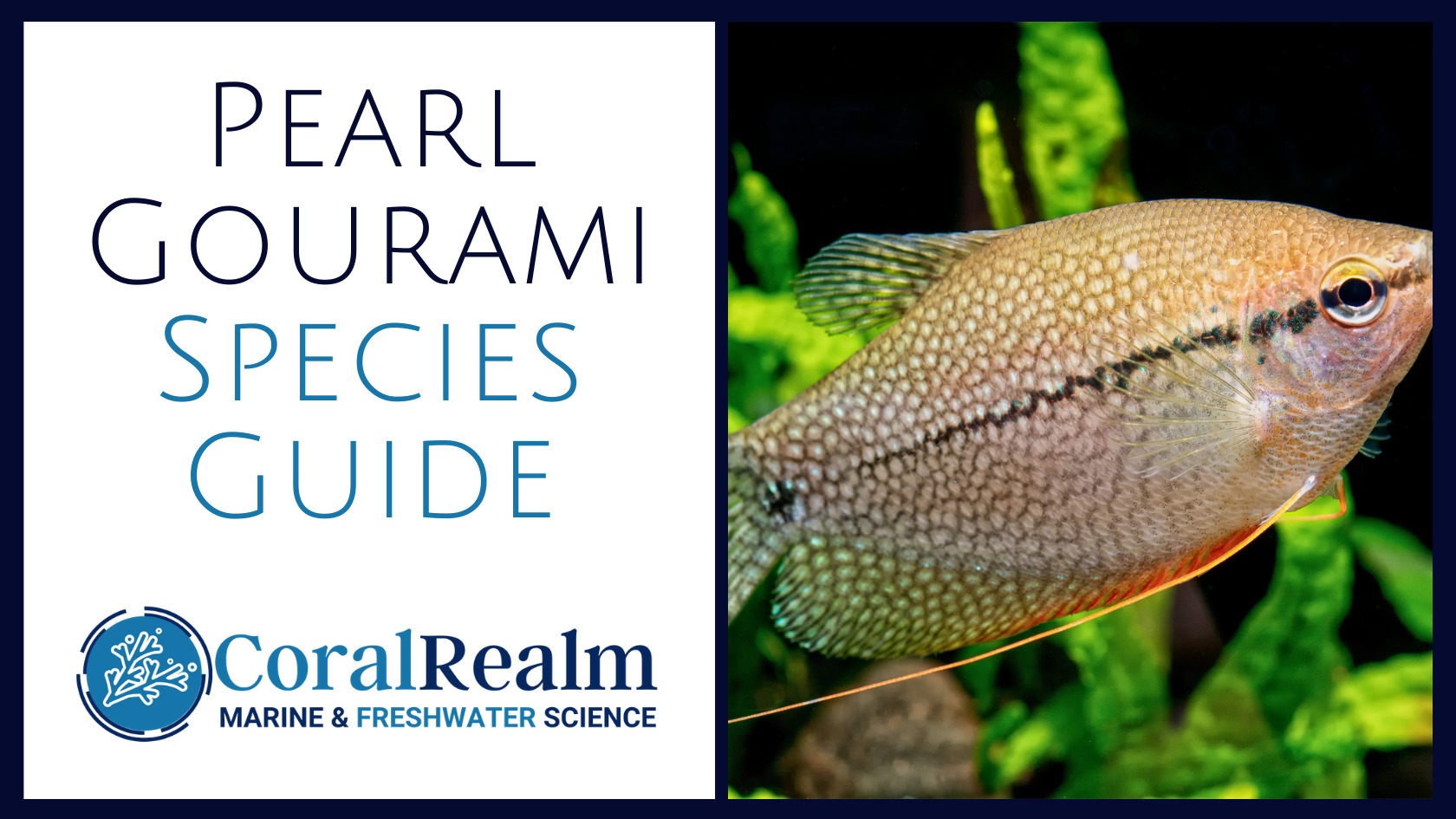
Pearl Gouramis are an exotic, tropical fish, and you will need to understand their behaviour and specific needs for them to thrive in an aquarium environment. As with all specialist fish, ideally you will be a more experienced aquarist and be prepared to do your research.
That said, the Pearl Gourami is a relatively hardy species and is usually long lived. Therefore, whilst a beautiful, topical variety, Pearl and other Gouramis are one of the easiest fish to keep belonging to the Belontiidae family. This is primarily due to their tolerance of most water conditions.
It is this tolerance to sub standard water quality that makes the Pearl Gourami a potential candidate for the novice aquarist. However, we do stress that to keep these beautiful fish healthy and happy in the aquarium, please do your research. We give much of the information you need in this care guide.
BREATHING MECHANISM
Pearl Gouramis, along with all the fish found in this group of fish, are also known as Labyrinth fish. They are so named after the labyrinth organ that these fish use to breathe air from the atmosphere. As with any fish, this species can extract oxygen from the water in which they live via the gills, but labyrinth fish have a secondary breathing option – breathing atmospheric air. The labyrinth organ is located in the gill cavity on the sides of the head, right above the gills.
Using this supplemental technique, these fish take in air by gulping above the water line. The air is taken into two chambers with a sponge like surface which has a large surface area and excellent blood vessel network. By this means, the fish can breathe atmospheric air and extract the oxygen directly from the air and into the bloodstream. The ability to breathe air allows labyrinth fish such as Pearl Gouramis to survive in oxygen deficient water. It also explains why they can cope with shallower water than many other aquarium fish.
BEHAVIOUR
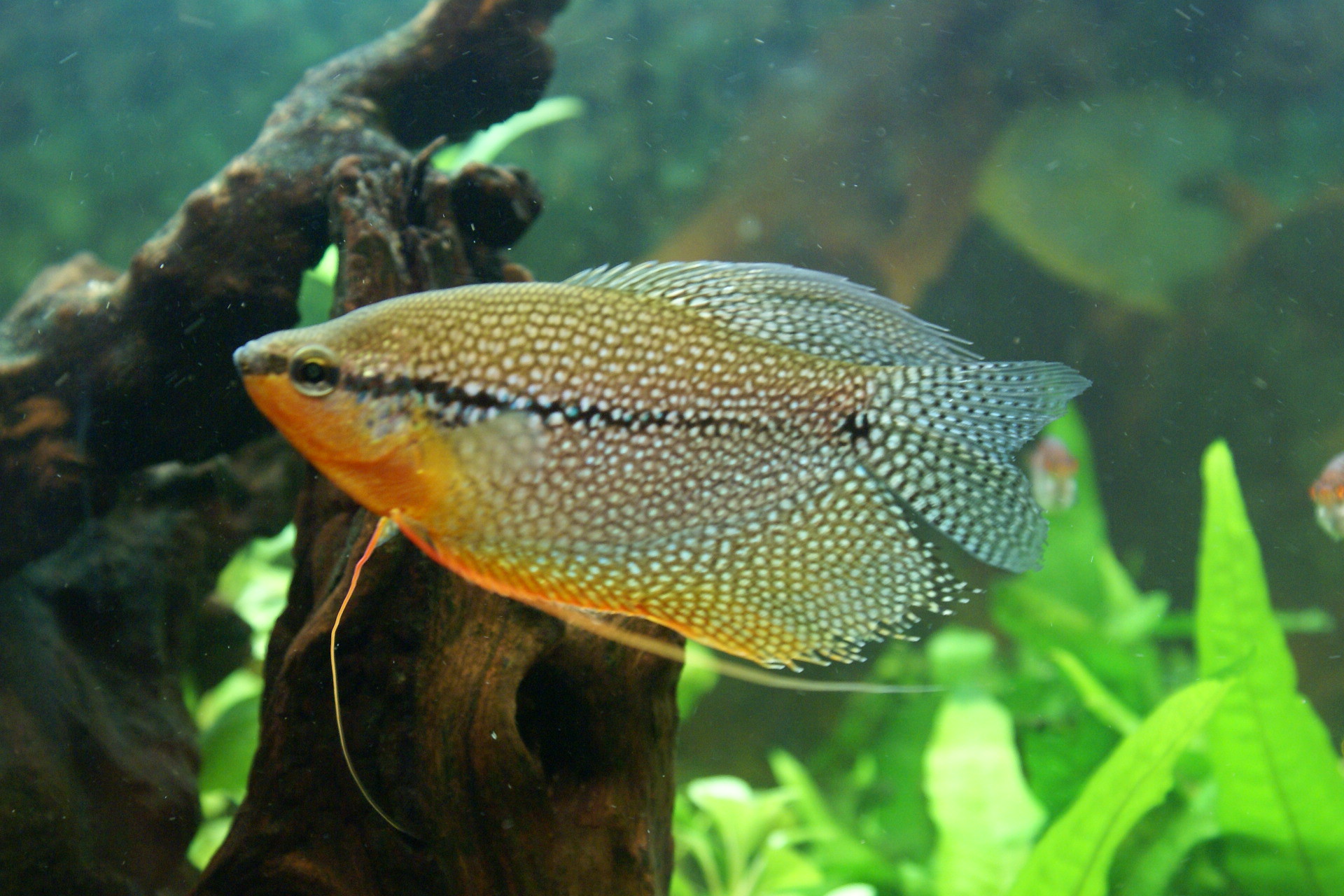
A Pearl Gourami prefers low light and lots of natural wood (CC BY-SA 2.0) by stee
Pearl Gouramis have many behavioural traits in common with others within the Gourami family.
On account of their labyrinth breathing mechanism, the Pearl Gourami will often be found at the upper or mid level of the aquarium. This is in order to readily take in air from beyond the surface of the water. By gulping in air, the Pearl Gourami can survive in poorer quality water with sub-optimal oxygen levels.
They enjoy space to swim and display to each other, but also relish the opportunity to seek solitude and peace amongst live planting and driftwood hideouts.
Whilst usually a peaceful fish living in harmony with its tank companions, Pearl Gourami can become more aggressive during the breeding season.
Pearl Gouramis enjoy group living, swimming in small shoals. The minimum number is a pair, but they do very well in groups of four or more. They are a social species so a group of Pearl Gouramis makes an excellent display in an aquarium.
They are peaceful and mild mannered in general, so make good tank companions for other species. Don’t include aggressive species with your Pearl Gouramis.
It is perfectly acceptable to keep more than one male Pearl Gourami in your aquarium, providing there is plenty of swimming space and appropriate planting; there needs to be sufficient plant cover within the tank.
The males can often be seen sizing each other up and sparring, but it is very uncommon for any significant harm to be done.
MARKINGS, COLOURATION AND FIN FORMATION
Pearl Gouramis make an attractive addition to an aquarium. With a slender shape and delicate fins, they are characterised by a black horizontal marking starting at the mouth area and continuing across the eyes and along the length of the body. This black line gradually fades as it progresses towards the tail.
As the name suggests, there are white spots reminiscent of pearls that adorn the vast majority of the body.
In the male of the Pearl Gourami, the fin rays of the anal fin are extended which is very distinctive. The male can also be distinguished from the female by its longer and more pointed dorsal fin. When kept in ideal conditions and they are in excellent health, the males can exhibit a deep red throat area which is really stunning.
Pearl Gourami can grow to a size of four to five inches in length.
AQUARIUM REQUIREMENTS, ENVIRONMENTAL NEEDS AND EASE OF MAINTENANCE
Trichogaster Leeri, the Pearl Gourami, is the one of the easiest of the Gouramis to keep in an aquarium setting; because they are tolerant to most water conditions.
Pearl Gouramis are best suited to a larger sized community aquarium. They need space to swim and to perform displays to their companions, especially during breeding activity.
OPTIMUM TANK AND WATER CONDITIONS FOR PEARL GOURAMI
Although Pearl Gouramis can tolerate less than perfect water condition and oxygenation, they do need the aquarium to be kept within a specific temperature range. If the tank water becomes too cold, your Pearl Gouramis will at best go off their food and become withdrawn, but they can become very ill.
Author’s Note
There needs to be some space between the aquarium lid and the water surface to give your Pearl Gourami the opportunity to breathe atmospheric air via their labyrinth mechanism. Ensure that you have a tightly fitting lid on the aquarium. This ensures that there is always a warm and humid air space just above the surface of the water.
You will need a distance of approximately 2 to 4 inches (5 – 10 cms) between the surface of the water and the aquarium cover.
The stats below gives you a succinct snapshot of the ideal aquarium conditions required for the Pearl Gourami, together with dietary and companionship information.
Minimum Tank Size : 36 inches (90 cms)
Minimum Tank Capacity : 30 Gallons
Planting : Generous natural planting
Temperature : 75 – 82 degrees Fahrenheit (24 to 28 degrees Celsius)
Lighting : Moderate lighting. Their natural environment is heavily planted with lower lighting levels. However, Pearl Gourami will not be troubled by stronger light provided they can seek shelter amongst the dense aquarium planting.
Water : Should be neutral, towards slightly hard (for General Hardness rating, see below).
Hardness of Water : 5 – 20 dGH
pH Level of Water : 6.0 – 7.5
Water Flow Rate/Movement : Slow. Very gentle water flow. Pearl Gouramis enjoy a lack of water movement which is also important to avoid disruption of any bubble nests. This emulates their natural wild habitat of the slow moving freshwater environments in Asia.
Oxygen Levels : Not important. Pearl Gouramis will tolerate sub-optimal oxygen levels due to supplemental atmospheric air breathing mechanism (labyrinth).=
Physical Environment : Dark substrate; to replicate their natural environment and show off their splendid colour. Plenty of hiding spaces such as Java Moss attached to driftwood. Floating plants are important; they provide shade, cover and hiding places.
Number in Aquarium : the minimum number of Pearl Gouramis in a tank is one pair.
Tank Companions/Compatibility : Community aquarium with peaceful tank mates. Pearl Gouramis enjoy a peaceful life! Don’t introduce overactive, aggressive or boisterous species to your gourami tank. Cichlids can be aggressive and should be avoided; they will stress your Pearl Gouramis causing them to lose their appetite, become withdrawn and even lose some of their beautiful colour.
Preferred region within the Tank : Pearl Gouramis will inhabit the middle to top region of the tank due to its supplemental breathing apparatus – the labyrinth.
Food/Diet : Pearl Gourami are omnivores, eating both plant and animal based foods. Prepared or live food, or a combination of both work well. Live or frozen aquatic invertebrates are excellent; including bloodworms, daphnia, mosquito larvae. Commercial pellets or flakes are also fine, preferably in combination with fresh food.
PLANTING AND DECORATION
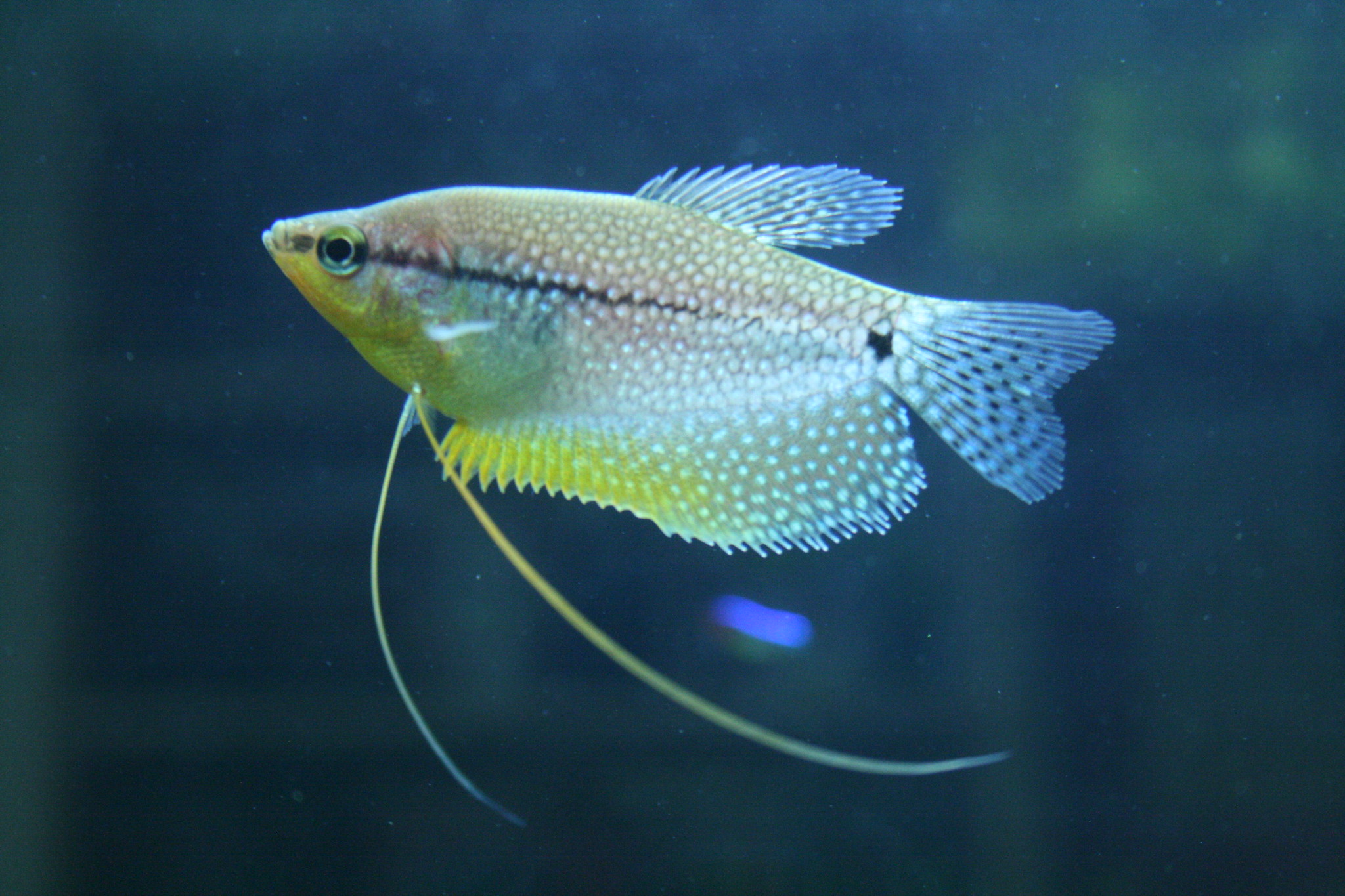
The Pearl Gourami’s ‘Feelers’ are actually pelvic fins – (CC BY-SA 2.0) by h080
As with any aquarium fish, the aquarist is always seeking to emulate the natural, wild environment of the fish species they keep.
Pearl Gouramis originate from slow moving freshwater environments in Asia and SouthEast Asia. From rivers, lakes to swamp regions, these areas share common characteristics : the waters are slow flowing, tending to shallow, and heavily supplied with plants and vegetation which provide much needed hiding places.
The densely planted swamp areas of Indonesia have little water movement and oxygen. This environment can be provided in the aquarium by heavily planting with natural, live aquatic plants. Use larger plants anchored in the substrate, and floating plants to provide anchors for the bubble nests.
In the wild, the Pearl Gourami is used to water that is slightly acidic. Adding carbon dioxide with help in maintaining water acidity (keeping pH levels in the acidic range). The carbon dioxide will also double as a plant fertiliser.
The addition of bogwood or driftwood with Java moss carefully attached will provide excellent hiding places for your Pearl Gourami and provide added interest to the tank.
TANK COMPANIONS FOR PEARL GOURAMIS
Pearl Gouramis are peaceful fish and can be kept in a community aquarium. Their tank mates, however, should not be too small. It can happen that larger adult Pearl Gouramis exhibit aggressive and bullying behaviour to its tank companions. If this occurs, these adults should be removed and set up in an aquarium with similar sized or larger fish.
This is not a common occurrence however. More common is for Pearl Gouramis to be on the receiving end of aggressive or nuisance behaviour from other species. Avoid aggressive species such as Cichlids which are renowned for irritating behaviour.
One thing to bear in mind – Pearl Gouramis have long, slender, flowing, threadlike ventral fins and these can sometimes be nibbled at by the Gourami’s tank companions. Do keep an eye out for any occurrence of this fin-nipping behaviour. Damage to your pearl gouramis’ fins can lead to fungus infiltration which will require treating.
It is perfectly acceptable to add other species that enjoy a freshwater environment such as nerite snails. Nerite snails are safe to keep with Pearl Gouramis. They are peaceful and will graze on algae which is helpful. They will not overpopulate the aquarium as the Nerite Snail requires salt water to breed. Other interesting non-fish companions for your Pearl Gourami are shrimps. They help keep the aquarium clean by eating food debris and algae.
BREEDING
Pearl Gourami are delicate, beautiful fish with delicate fins, but they really come into their own during the breeding season when they are even more colourful.
Even if you keep your Pearl Gouramis in a community aquarium alongside other species, if kept in pairs they may well breed. As long as the tank companions are peaceful, the Pearl Gouramis stand a good chance of reproducing and spawning.
Pearl Gouramis are bubble nest or foam nest builders. The male is responsible for the building of the bubble nest. He will take air in via mouth and expel it through the gills. This process will form bubbles which are covered in a lubricative mucus.
These bubbles will float towards the surface of the aquarium water. It is important that you have some floating aquarium plants as it is the leaves of these plants that gently contain these bubbles in clumps and prevent them dispersing. Also provide dense thickets of planting, including some plants that stretch up to the surface of the water. These provide discreet places for hiding which will help the females find shelter if the males become persistent.
The aquarist keeping Pearl Gourami should not employ a strong filtration mechanism; minimal filtration is the key. The current and water flow within the Gourami aquarium should be gentle and not strong flowing. The gentle current will prevent the destruction of the delicate bubble nest.
The male Pearl Gourami does not only build the bubble nest. He will guard, protect and maintain the nest to house the eggs and subsequent fry.
BREEDING YOUR OWN PEARL GOURAMI
Feed your pearl gourami, both male and female, with nutritious food for approximately two weeks before attempting to breed them. Choose a selection of live food such as bloodworms, daphnia and mosquito larvae, together with a good quality flake and green food. This will ensure that they are in prime conditions before mating.
An experienced aquarist may choose to use a breeding tank specifically to facilitate the mating process. If this is the case, allow the female to spend some time alone in the breeding tank to become settled and familiar with the surroundings.
Continue with the conditioning diet during this time to give the female the best chance to successfully reproduce.
Wait a few days for the female to settle in. Pearl Gourami are egg layers, not live bearers. The female becomes gravid/full of eggs prior to laying, where her body becomes swollen with the eggs inside her.
The male needs to be sexually mature for successful breeding to take place. Also, there needs to be a suitable tank environment with sufficient live surface planting for the creation of a bubble nest to safely house the eggs and subsequent fry.
If you are keeping your Pearl Gourami all together in the aquarium, rather than using a breeding tank, a ratio of one male to two or three females should be appropriate. Too many males can cause unnecessary aggression amongst the males.
Take particular care to ensure water movement is very gentle to avoid damaging the delicate bubble nest.
After introducing the male to the breeding tank he may start paying close attention to the female, not straying far from her side and ‘cradling’ his body around hers. He will be interested in the round appearance of her belly in her gravid condition, with her belly full of eggs. It is at this point that the male will start to build the bubble nest, but he will take time off occasionally from his labours to court the female.
He will wiggle his body to entice the female – if this is successfully done, she will spawn as soon as he has completed the bubble nest. Unfortunately, if she is not yet ready to spawn, there is a chance that they will fight. Keep a very watchful eye, as you may have to remove the female to avoid damage to her fins etc.
The male will fertilize the eggs as they are released by the female. The eggs will then float up to the bubble nest. The male will continue his role as protector of the bubble nest with the developing eggs. In a community tank, the eggs may be vulnerable to other hungry fish.
Fry will hatch from the eggs from 24 hours onwards after laying. You may see their little tails protruding from the underside of the bubble nest. It will take approximately four more days before they start to swim.
This is the time you need to feed them with infusoria several times per day as the fry will have already absorbed/eaten their yolk sac. Infusoria are microscopic aquatic organisms of both plant and animal origin which you can purchase from aquarium stores as commercially produced liquid food.
By ensuring your fish are fed a high quality diet, providing the right environment and water quality, and keeping the water movement slow, you will probably find your Pearl Gourami breed quite easily.
It can be extremely rewarding to observe this process, particularly the building and defending of the bubble nest by the males.
DIET AND FEEDING REQUIREMENTS OF PEARL GOURAMI
As with any captive, aquarium fish, a good quality diet is essential for health, growth and the propensity to mate and breed.
Pearl Gouramis are omnivores; namely, they can eat food from both plant and animal sources.
Dense planting with the aquarium will provide opportunities for grazing, but this is not the main component of their feed. You can use prepared or live food, or a combination of the two types. Aquatic invertebrates are excellent, regardless of whether they are frozen or live. You can select from bloodworms, daphnia, brine shrimp, mosquito larvae and glass worms; all will provide excellent nutrition for your Pearl Gouramis.
As Pearl Gouramis enjoy a graze on the live planting and vegetation within the tank, you can ring the changes by adding little pieces of cut up vegetables occasionally. This could include zucchini (known as courgette in the UK) or broccoli.
Commercial pellets or flakes available from pet stores and retailers are also fine for your Pearl Gourami, but we feel this should be in support of, and preferably in combination with, a high quality fresh food as already described.
As with any aquarium fish, don’t be tempted to overfeed. Excess, uneaten food forms as debris on the substrate on the base of the tank.
Feed twice or three times daily, and observe the feeding habits of your fish. You will soon become accustomed to how much is needed at each sitting to avoid waste and debris build up. Giving the quantity that will be easily consumed in a few minutes will be ideal, and you will soon be able to gauge this through careful observation.
DISEASE AND ILLNESS
There are no diseases that are specific to the Pearl Gourami. However, they have delicate trailing fins that can be nipped at by more boisterous tank mates. This can result in fungus or fin rot which will require treatment.
As Pearl Gourami survive in tanks with oxygen deprived water, and the water quality is sub-optimal, this can exacerbate any risk from fin damage.
Prevention is always better than cure, so keep an eye on the inter-relationship between your Pearl Gouramis and their tank companions. Separate any overly aggressive tank mates to avoid harm to your gouramis.
CONCLUSION – HOW SUITABLE ARE PEARL GOURAMIS FOR YOUR AQUARIUM
The Pearl Gourami is a sociable, mild mannered character which makes it ideal for a community aquarium.
This is not a high maintenance species. Whilst we always advocate that you do your research and provide the best environment and feeding regime that you possibly can, the Pearl Gourami is suitable for both the novice (but diligent!) fish keeper and experienced aquarists alike.
Beautiful in appearance, and gentle in behavior, the Pearl Gourami will make a wonderful addition to any tank. Whether kept in a shoal in a species specific aquarium or selected as tank mates in a community setting, they should live peacefully.
There are some basic rules that we have outlined in our guide above.
Create some dense natural planting. Plant some into the substrate, with a few reaching up to the water’s surface, and include some floating varieties too. This is important for hiding spaces and bubble nest creation.
Use a dark substrate. As with the planting techniques, the dark substrate will emulate their natural habitat.
Author’s Note
Follow the feeding recommendations above. Prioritize fresh live food over proprietary foods. Don’t overfeed at each sitting. Take time to study the feeding patterns and consumption rates of the Pearl Gourami.
Reading our guide and following these simple rules will ensure that your Pearl Gouramis integrate well into your community aquarium.

